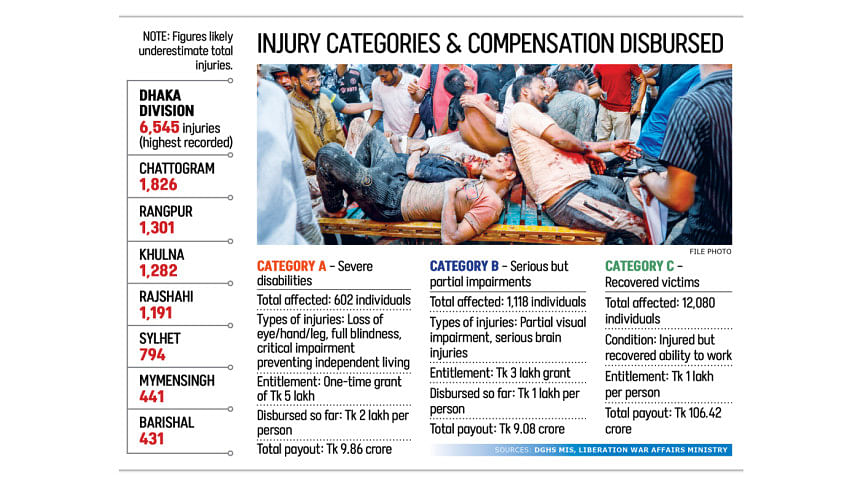July uprising: The wounds that are yet to heal, one year on

This week marks one year since 15-year-old Md Shahin Alam's life was forever changed -- not by illness or accident, but by a bullet that tore through his left leg during a rally on August 5, 2024.
He was unarmed and part of a jubilant crowd outside Uttara East Police Station during the Victory March that followed the fall of the Awami League government.
Today, Shahin lies bedridden at the National Institute of Traumatology and Orthopaedic Rehabilitation (NITOR), his leg still held in external fixators after eight surgeries. With no clear timeline for recovery, his future is clouded by pain, poverty, and uncertainty.
A 10th grader from Mymensingh, Shahin had been visiting his parents in Dhaka during school holidays. His father pulls a rickshaw. His mother, a domestic helper, quit her job to care for him full time.
"It was around 4:00pm," Shahin recalled. "They fired tear gas first. I couldn't move. Then a policeman shot me just below the knee. I collapsed on the spot."
Doctors say the fixator may be removed soon, but will likely be replaced, possibly more than once.
Shahin spends his days mostly idle, scrolling through short videos on his phone. "I can stand a little," he says softly. "I can walk a few steps with crutches. That's all."
The family has received Tk 4 lakh in aid: Tk 2 lakh from the July Shaheed Smriti Foundation and the rest from the government. "We used it all for treatment. I just want to study. I want to walk again. I want my life back."
NUMBER OF INJURED
But Shahin is not alone.
According to the Directorate General of Health Services, 13,811 people were injured during the uprising, most of them in Dhaka Division. Injuries ranged from gunshots and pellets to tear gas and blunt trauma. Some victims suffered burns.
Government data show that 20 individuals lost a leg, four lost an arm, 20 were blinded in both eyes, and 450 lost vision in one. Hundreds more suffered spinal, cranial or internal injuries.
The July Uprising Martyrs' Families and July Fighters' Welfare and Rehabilitation Ordinance, issued on June 17, formally recognised 12,043 injured people in three categories: A, B and C. In another gazette issued on July 28, the government included an additional 1,757 names.
So far, Tk 202.56 crore has been disbursed in one-time aid, with the rest planned for 2025–26. Monthly allowances of Tk 20,000, Tk 15,000 and Tk 10,000 are promised under Categories A, B and C respectively, but timelines remain unclear.
'THOSE WHO PAID THE PRICE ARE FORGOTTEN'
Despite losing his left leg, 19-year-old Md Akash Mia from Netrokona was placed under Category B, which is meant for less severe injuries.
"There are people with lighter wounds in Category A," he said, pointing to inconsistencies that affect medical and financial support.
Akash, an employee of a sweet shop, had been preparing to migrate to Saudi Arabia to support his farming family. On July 20, 2024, while helping a fellow protester, police followed him back to his sweet shop in Narayanganj.
"I was closing the shutter of the shop. They forced their way in, beat the owner, smashed everything, then shot six or seven pellets below my knee."
With no public transport available, Akash was first ferried on a vegetable cart, then picked up by an ambulance. By the time doctors saw him, six hours had passed.
Between July 20 and 22, he was taken to five hospitals before his leg was amputated at NITOR on July 23. "When the prime minister visited, people feared another police raid," he said. His family, alarmed by inquiries, discharged him on August 1. They have been treating his wounds at home since.
So far, Akash has received Tk 3.5 lakh -- one lakh from the government, one lakh from the July Foundation, and the rest from his employer. "We still owe my aunt Tk 50,000."
Now fitted with a prosthetic leg, he said, "I don't want sympathy. Just a fair chance to stand on my own feet again."
Over the past year, anger over delays and poor care has driven many injured protesters to the streets. They blocked roads in Shahbagh and Agargaon, held sit-ins outside the Secretariat and the chief adviser's residence, and even tried to obstruct the health adviser's motorcade after a hospital visit.
In a desperate moment last May, four injured people attempted suicide by ingesting poison during a meeting at the National Institute of Ophthalmology.
The government, citing injury severity, sent 75 patients abroad for advanced care, mostly to Singapore, Thailand, Turkey and Russia, at a cost of over Tk 78 crore. Another 32 remain on the waiting list. Medical teams from the UK, USA, France, Singapore, China and Nepal have visited to support local hospitals, but long delays remain.
Few cases reflect that better than Khokon Chandra Barman, a driver from Sherpur. On August 5, he begged police not to shoot outside Jatrabari Police Station. They did anyway -- at point-blank range. The bullet pierced his upper lip, gums, nose and palate. His speech is now slurred, often unintelligible.
Initially approved for surgery in Australia, Khokon was later redirected to Russia, where doctors proposed a three-stage procedure. The first was completed in March. The second, scheduled for July, was delayed after his government-appointed travel companion was barred from flying over corruption charges.
"Why should I suffer because someone else broke the law?" Khokon asked.
After months of appeals, he was told just days ago that his surgery has been rescheduled for August 12.
"Everyone's busy with politics, but we who paid the price are now forgotten.... I'm just waiting to look in the mirror and recognise myself again."

 For all latest news, follow The Daily Star's Google News channel.
For all latest news, follow The Daily Star's Google News channel. 



Comments